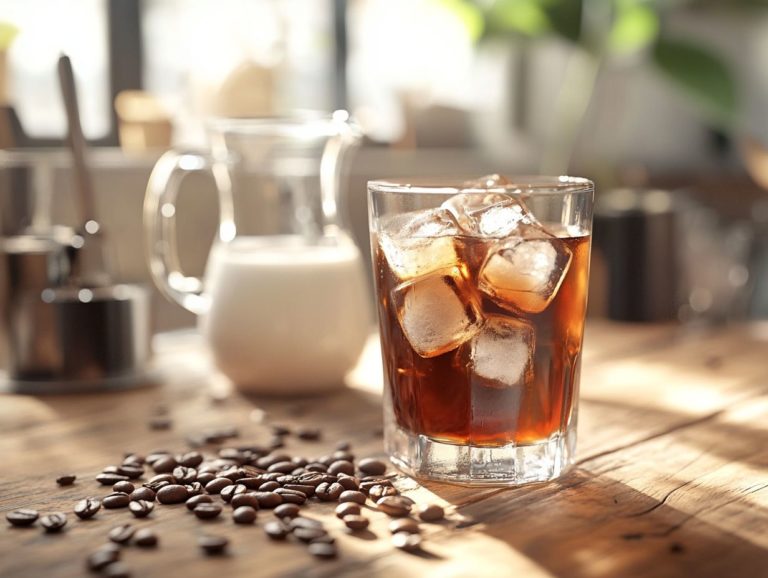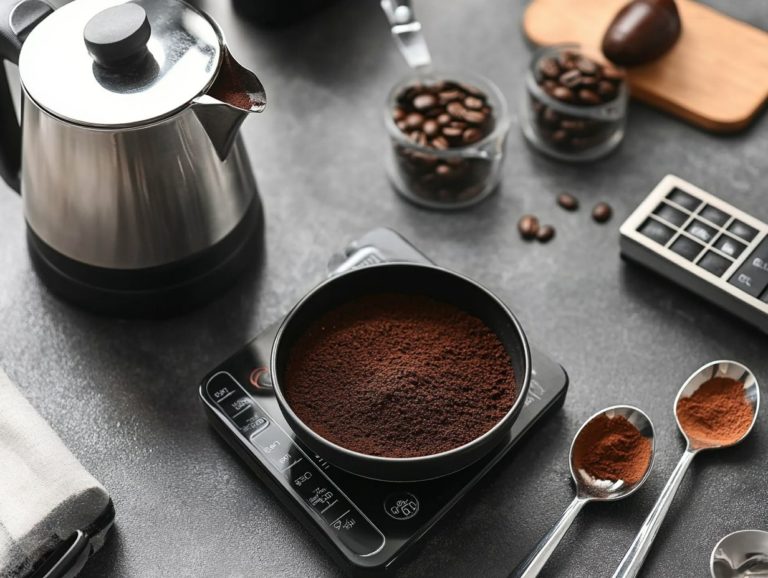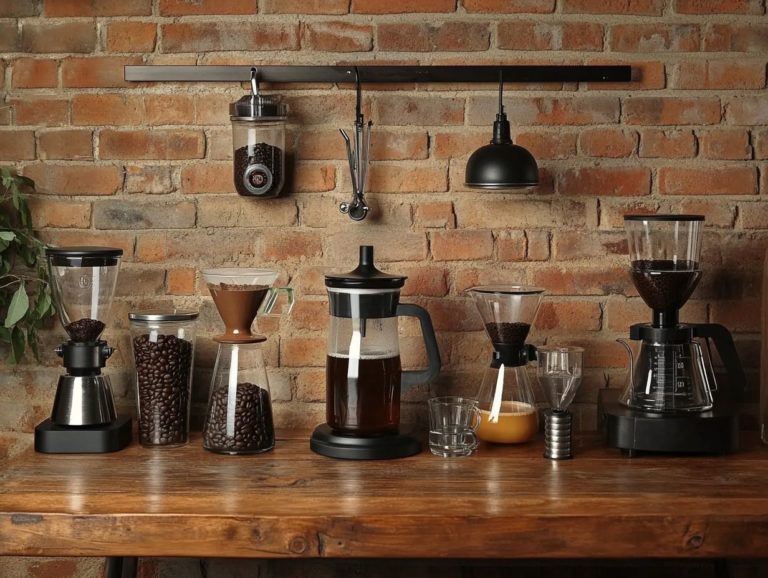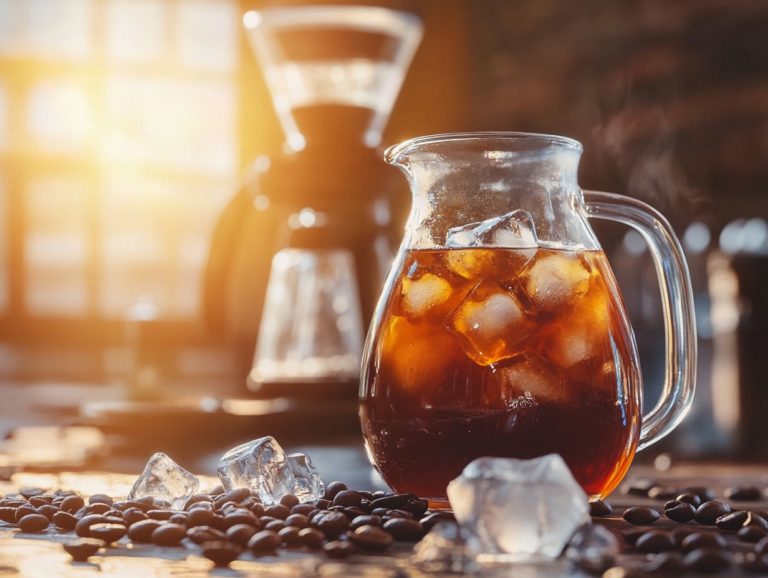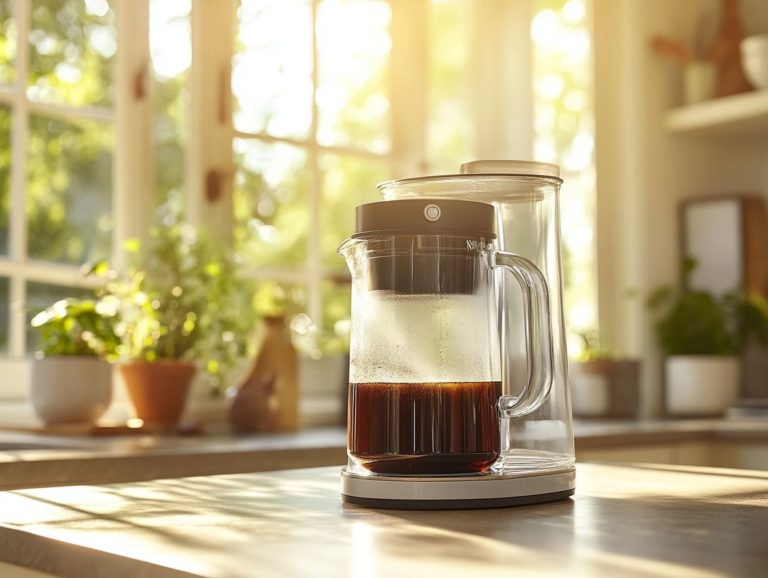Essential Brewing Techniques for Home Baristas
Crafting caf -quality espresso at home may seem like an intimidating endeavor, but with the right techniques and a bit of practice, you can effortlessly master the art of coffee brewing.
This guide will equip you with the essential skills you need, from selecting the perfect coffee beans to mastering the intricacies of milk frothing and creating stunning latte art.
You ll also discover how to maintain your equipment and troubleshoot common pitfalls. Whether you re just starting out or aiming to refine your skills, these insights will undoubtedly elevate your home coffee experience to new heights.
Contents
- Key Takeaways:
- 1. Choosing the Right Beans
- 2. Properly Storing and Grinding Beans
- 3. Understanding the Importance of Water Quality
- 4. Mastering the Basics of Espresso Extraction
- 5. Perfecting Milk Steaming and Frothing
- 6. Learning Latte Art Techniques
- 7. Experimenting with Different Brewing Methods
- 8. Understanding the Role of Temperature and Pressure
- Essential Coffee Brewing Tips for Home Baristas
- 9. Proper Maintenance and Cleaning of Equipment
- 10. Continuously Refining and Improving Techniques
- What Are the Essential Tools for Home Baristas?
- Frequently Asked Questions
- What are essential brewing techniques for home baristas?
- Why is grind size important in home brewing?
- What is the best water temperature for brewing coffee at home?
- How important is brew time in home brewing?
- What is the recommended coffee-to-water ratio for home brewing and different brewing methods?
- How can I ensure consistency in my home brewing techniques as a home barista?
Key Takeaways:
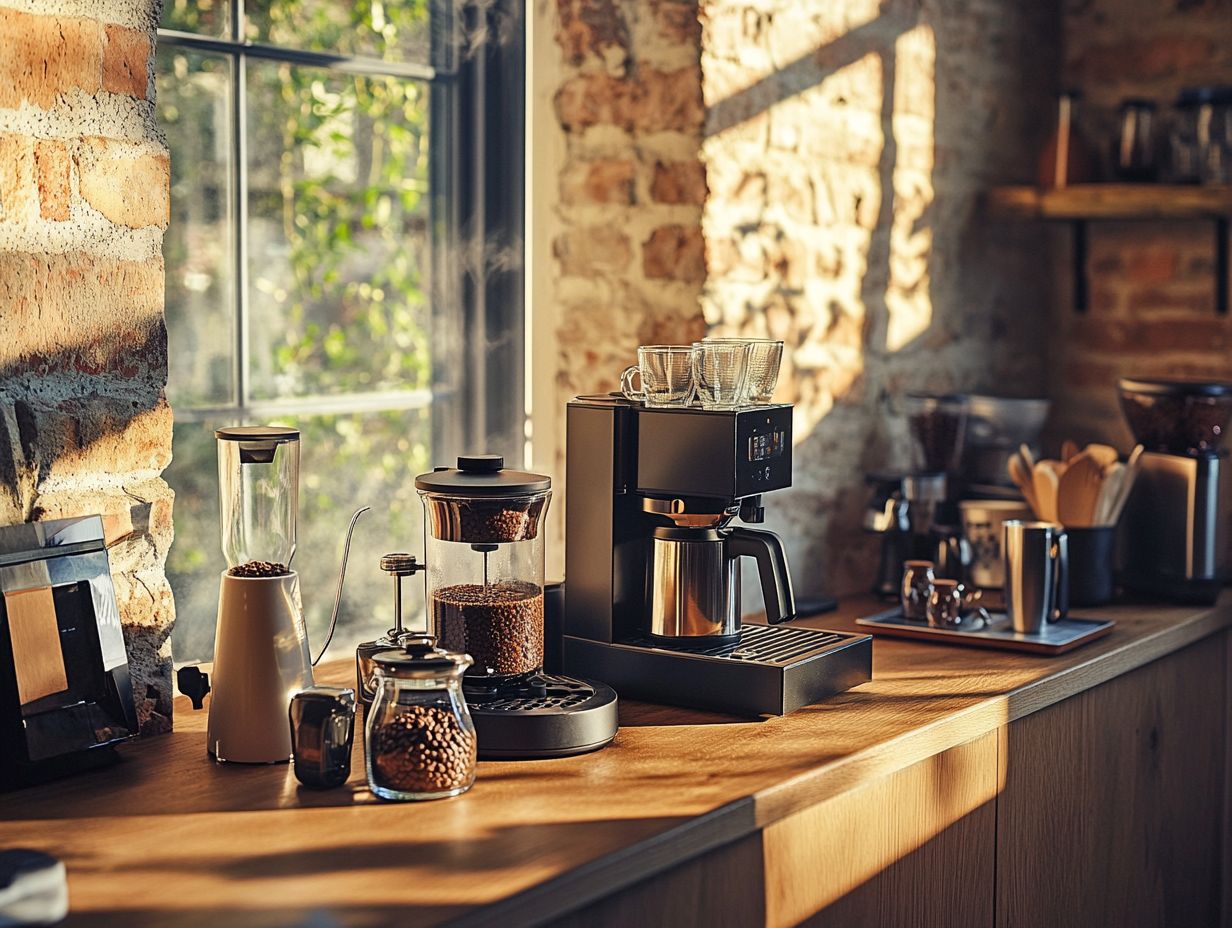
- Choose high-quality coffee beans and understand their origin to create the best-tasting coffee.
- Store coffee beans in a cool, dark place and grind them right before brewing for maximum flavor and freshness.
- Water quality plays a crucial role in the taste of your coffee, so invest in a good filter and use filtered water.
1. Choosing the Right Beans
Choosing the right coffee beans is crucial for you as a home barista. The quality and characteristics of the beans directly influence the flavor notes and overall experience of your brewed coffee.
Specialty coffee presents a diverse array of beans, each with its unique flavor profile that caters to different tastes. Understanding the nuances of each type is essential for any coffee enthusiast.
For example, beans sourced from regions like Portland are celebrated for their distinct flavors. Selecting the right variety can elevate both your coffee-making skills and your enjoyment. Consider exploring beans from renowned suppliers like Verve or Onyx.
Two primary types of beans reign supreme: Arabica and Robusta. Arabica beans are often your go-to for their sweet, soft taste and a wide range of flavor notes, frequently showcasing fruity, floral, or chocolate undertones.
Robusta beans pack a stronger punch, often described as earthy or nutty with lower acidity and a more bitter profile.
The region and altitude where these beans are cultivated greatly influence their taste. Higher elevations typically yield beans that boast more complex flavor profiles.
Freshness is another key factor; freshly roasted beans can dramatically enhance the final brew.
Looking for quality beans? Explore local roasters or reputable specialty coffee shops that prioritize ethically sourced beans. Options like online subscriptions or fair-trade certified retailers can truly elevate your coffee experience!
2. Properly Storing and Grinding Beans
Properly storing and grinding your coffee beans is paramount for preserving their freshness and elevating the flavor of your brew. Coffee grounds lose their rich flavor quickly if they aren’t handled with care.
To maintain optimal taste, keep your coffee beans in airtight containers. This simple step shields them from air, moisture, and light elements that can lead to degradation.
Store them in a cool, dark place, away from heat sources, as temperature fluctuations can also compromise that exquisite flavor you crave.
The grind size you choose should align with your brewing method. A coarse grind is perfect for a French Press, allowing for a delightful longer steeping time, while a fine grind is essential for espresso, which requires hot water to pass through quickly for a rich flavor.
Understanding the nuances of grind size is crucial, as it directly impacts the extraction rate and ultimately influences the final taste of your coffee. Check the grind recommendations for each method to ensure the best results.
3. Understanding the Importance of Water Quality
The quality of water you use in brewing coffee is paramount. For any coffee enthusiast, water quality should be a top consideration. It plays a critical role in the extraction process and can significantly affect the taste of your final cup.
Aim to maintain the water temperature between 195 F and 205 F. This sweet spot facilitates optimal extraction without scalding your precious coffee grounds. The mineral content think calcium and magnesium can elevate flavor notes, resulting in a smoother and more balanced brew.
Keep in mind that different water sources, from your standard tap to artisanal spring water, vary in mineral composition and pH, which can subtly alter your coffee’s taste profile. If you re on a quest to perfect your brew, consider using filtered water that strikes the right balance of minerals while steering clear of chlorine or impurities.
Investing the time to select and prepare high-quality water will undoubtedly elevate your entire coffee experience. Some coffee enthusiasts prefer using artisanal spring water for its unique mineral composition.
4. Mastering the Basics of Espresso Extraction
Mastering the basics of espresso extraction is essential for you as an aspiring home barista. It involves understanding the nuances of using an espresso machine to achieve optimal coffee extraction through precise brew ratios and timing.
Your journey begins with selecting the right coffee beans, a pivotal choice that will greatly influence the flavor profile of your final brew. Equally important is the grind size; it should be fine enough to facilitate proper extraction but not so fine that it clogs the filter.
When you tamp the coffee grounds, applying consistent pressure is key to ensuring an even surface for optimal water flow. Water temperature also plays a crucial role, influencing how effectively flavors and oils are extracted from the coffee.
A typical brew ratio is 1:2, meaning for every gram of coffee, you should use two grams of water. You can adjust this based on your personal taste preferences. Regularly running a cleaning cycle on your espresso machine can help maintain optimal performance.
Experiencing sourness or bitterness in your espresso? That s your cue to refine your espresso-making skills. Often, these issues signal problems with grind size or tamping pressure, presenting valuable opportunities for improvement.
5. Perfecting Milk Steaming and Frothing
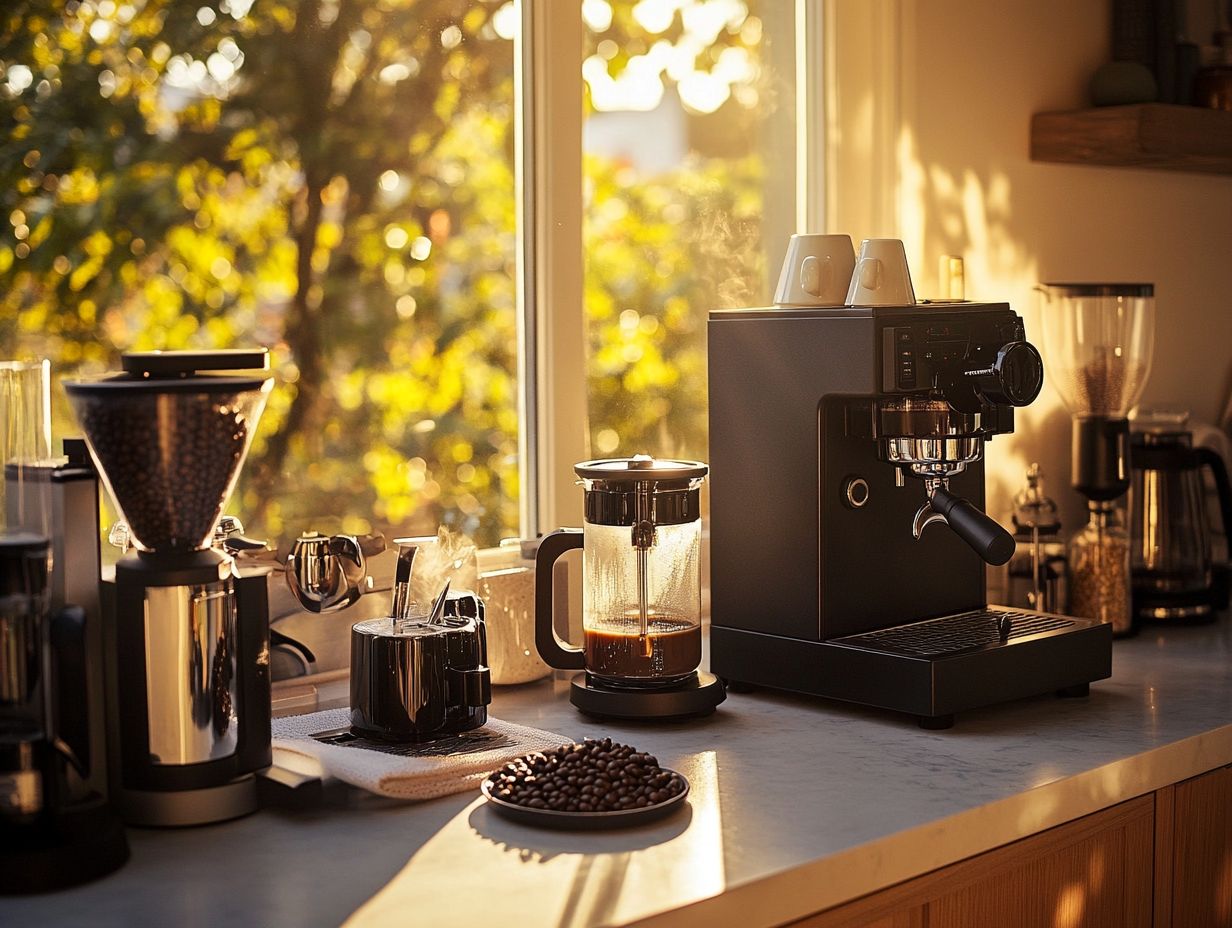
Perfecting your milk steaming and frothing techniques is crucial for crafting caf -quality espresso drinks. The texture and temperature of the milk elevate both the flavor and visual appeal of your lattes and cappuccinos. Consider using brands like Oatly for plant-based alternatives.
You can employ various methods to achieve that desired velvety foam. The classic steam wand reigns as the gold standard for those lucky enough to have an espresso machine. A steam wand injects hot steam into the milk, seamlessly incorporating air to create a luxurious microfoam.
If you don t have a steam wand, don t worry there are plenty of alternatives. Handheld frothers and French presses can also do the trick. Keep in mind that the type of milk you choose can significantly impact your results.
Many baristas swear by whole milk for its rich creaminess, while vegans often opt for Oatly or other plant-based alternatives, which can surprisingly froth well and introduce their own unique flavors to your creations.
6. Learning Latte Art Techniques
Learning latte art techniques is a truly rewarding skill for you as a home barista, allowing you to turn a simple espresso and milk combination into visually stunning creations that will impress coffee enthusiasts and elevate your beverage presentation.
Mastering these techniques is all about grasping the crucial role of milk texture, which you can achieve through proper steaming methods that create microfoam. This velvety milk is essential for executing popular designs like the classic heart or the more intricate rosetta, both of which can add a delightful flair to your drinks.
To enhance your skills, experimenting with different pouring angles and speeds will help you manipulate the milk s flow, enabling you to create varying patterns. Dedicating time to refine your technique using a simple pitcher and various types of milk can lead to remarkable progress, transforming your coffee experience into an art form.
7. Experimenting with Different Brewing Methods
Experimenting with different brewing methods can be an exhilarating adventure for you as a coffee enthusiast. Each technique whether it’s the French Press, AeroPress, or pour-over offers unique flavor profiles and extraction styles that can elevate your coffee experience to new heights. Don’t forget to explore other tools like the Kalita Wave, Hario V60, and Chemex.
Understanding these subtle distinctions can profoundly enhance your appreciation for every cup you brew. For example, the French Press retains oils and fine particles, resulting in a rich, full-bodied coffee that envelops your palate. In contrast, the pour-over method highlights brightness and clarity, allowing water to cascade over the coffee grounds in a controlled fashion, unveiling the delicate flavors within. You can also try the Bialetti for a unique brewing experience.
Adjusting the grind size for these methods is crucial coarse for the French Press and medium-fine for pour-over enabling you to customize the flavor to your liking. Start with standard coffee-to-water ratios, then feel free to tweak them based on your taste preferences.
Embrace the art of experimentation; it s your path to discovering that perfect signature brew that speaks to your unique palate. Consider following detailed brewing guides from reputable sources like Clive or Greater Goods.
8. Understanding the Role of Temperature and Pressure
Understanding the role of temperature and pressure is critical in brewing methods like espresso, pour-over, French Press, and AeroPress. Each method requires precise control to achieve the perfect brew.
Understanding the role of temperature and pressure in any brewing method is essential for achieving the finest extraction. These factors directly impact how flavors and aromas are drawn from the coffee grounds during the brewing process, and exploring brewing techniques for a richer coffee experience can enhance your skills.
Different brewing methods come with their own ideal temperature ranges. For instance, if you’re using a French press, you’ll find that temperatures around 195 F to 205 F yield the best results, while pour-over methods excel at slightly lower temperatures, around 190 F to 200 F. On the other hand, espresso demands precise pressure, typically between 9 to 10 bars, which is crucial for extracting those rich flavor notes from the coffee.
By fine-tuning these parameters, you can unlock the unique characteristics inherent to various coffee varieties, such as accentuating fruity or nutty undertones, ensuring that each cup is a personalized masterpiece that perfectly aligns with your taste preferences. This is especially true for specialty coffee and high-quality coffee beans.
Essential Coffee Brewing Tips for Home Baristas
9. Proper Maintenance and Cleaning of Equipment
Proper maintenance and cleaning of your coffee equipment, particularly the espresso machine, are essential practices for any home barista.
By ensuring these routines are executed, you can enjoy longevity and consistent quality in every cup you brew.
Routine tasks like descaling and performing regular cleaning cycles are pivotal in keeping your machine in good shape and the flavor of your coffee intact.
Ignoring these important steps can lead to a pesky build-up of mineral deposits, which not only compromises taste but can also hinder your machine’s performance, resulting in a bitter or sour brew. This is especially a concern for coffee enthusiasts.
To prevent this from happening, consider establishing a comprehensive checklist for maintaining your brewing equipment. This might include:
- Regularly descale your machine
- Clean the water reservoir
- Check and replace water filters
- Ensure the group head, portafilter, and steam wand are thoroughly cleaned after each use
By adhering to this regimen, you will significantly enhance the quality of the coffee you enjoy while extending the life of your cherished equipment. This practice is recommended by experts in their brewing guides.
10. Continuously Refining and Improving Techniques
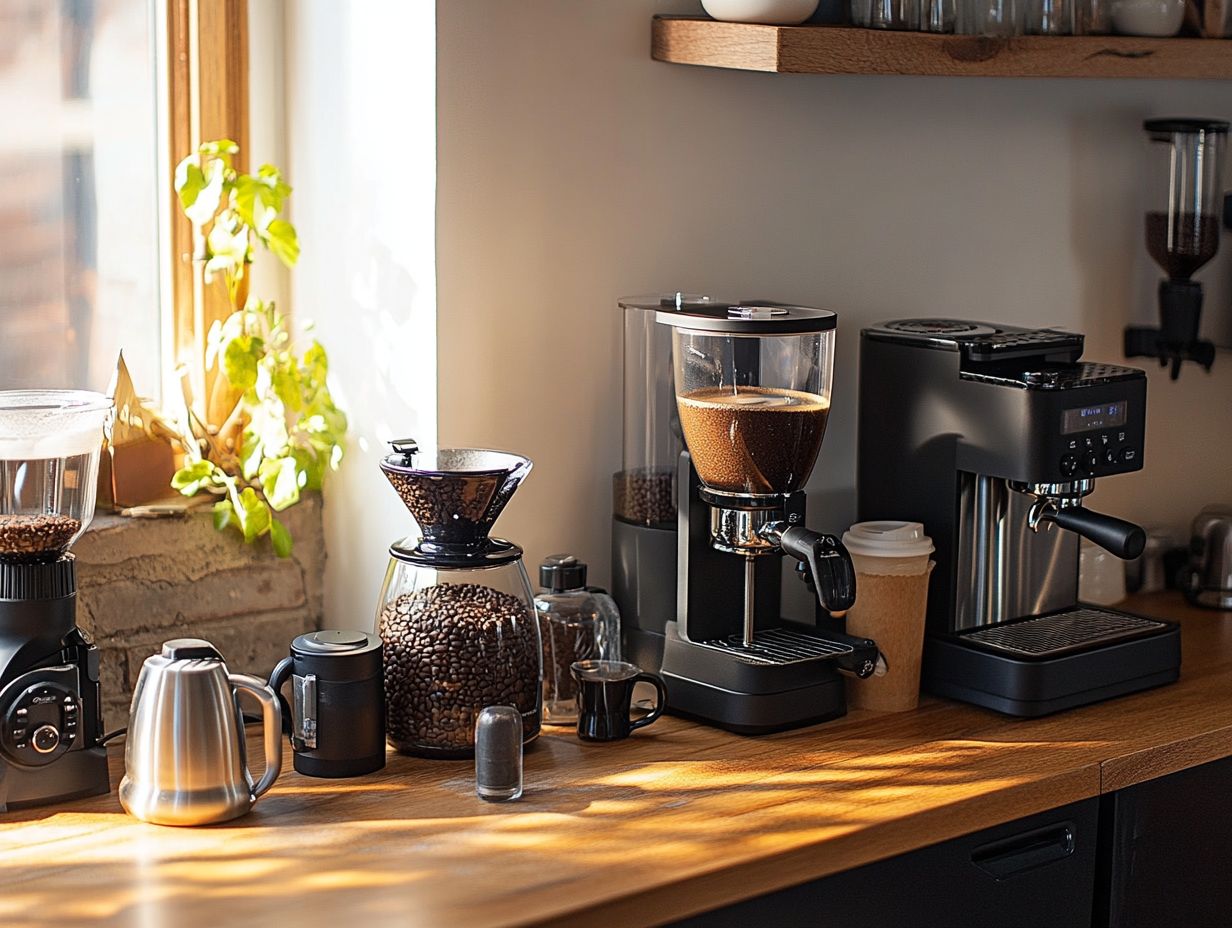
Continuously refining and improving your coffee brewing techniques is a rewarding journey for any coffee enthusiast.
This process allows you to adapt to new trends and deepens your understanding of the intricate art behind each cup of coffee.
Explore various brewing guides, attend workshops, and join community events to uncover methods and insights from fellow coffee lovers.
These experiences not only expand your knowledge but also foster valuable interactions that can lead to constructive feedback.
Embracing the practice of refining your techniques over time will undoubtedly elevate the quality of every brew. Jump into your local coffee community for support that fuels your passion and helps you master the art of coffee brewing.
What Are the Essential Tools for Home Baristas?
Equipping yourself with the essential tools for a home barista setup is vital for brewing exceptional coffee.
Whether you’re using a Kalita Wave, Chemex, Bonavita, or Hario V60, the right tools make all the difference.
The right equipment including a reliable espresso machine and a quality coffee grinder can significantly enhance your coffee-making experience.
Investing in quality brewing devices such as a French Press or AeroPress provides you with versatility in your brewing methods, allowing you to cater to different tastes and preferences.
The precision of a good grinder ensures that your coffee beans are ground to the perfect consistency, which is crucial for achieving the desired flavor profile.
Don t overlook accessories for steaming milk, like a frothing pitcher or steam wand; these are essential for creating creamy lattes and cappuccinos that rival those from your favorite caf .
Brands such as Bialetti and Oatly offer excellent options.
A thoughtfully chosen selection of tools not only elevates your coffee artistry but also transforms the brewing process into a far more enjoyable experience.
Start your coffee journey today with these essential tools and tips!
What Are the Common Mistakes Made by Home Baristas?
As a home barista, you may struggle with common mistakes. These include incorrect grind sizes, improper water temperatures, and inconsistent brew ratios. Such missteps can lead to coffee experiences that fall short of your expectations. Even seasoned baristas at a coffee shop find themselves fine-tuning these elements.
These issues not only compromise the flavor and aroma of your coffee but can also discourage you from experimenting with different brewing techniques. For example, if your grind is too coarse, you might end up with a lackluster cup. On the other hand, a grind that’s too fine could lead to over-extraction, resulting in a bitter brew. Using water that is either too cold or too hot can disrupt the balance of flavors. Aim for that sweet spot between 195 F and 205 F for optimal brewing, especially when using equipment like the Kalita Wave or Hario V60. To enhance your skills, learn how to perfect your brewing technique.
Maintaining a consistent brew ratio ideally around 1:16 coffee to water is crucial for achieving a well-rounded taste. By recognizing these common pitfalls and making small, strategic adjustments, you can elevate your brewing skills and significantly enhance your coffee outcomes. Reference guides from Clive or Greater Goods can be particularly useful.
How Can a Home Barista Create a Cafe-Quality Drink?
You can easily create caf -quality drinks at home and impress your friends! By mastering essential techniques from selecting the perfect espresso beans to perfecting your milk frothing skills and employing precise brewing methods you can elevate your coffee game to new heights.
To truly refine your coffee-making skills, experiment with various ingredients. Consider using organic milk or specialty syrups that can enhance the flavor profiles of your beverages. Familiarizing yourself with different brewing equipment, like pour-over cones, French Press, or even AeroPress, can also significantly impact the final taste of your coffee.
Don’t underestimate the importance of water temperature and grind size; these factors are crucial for extracting the best flavors from your coffee grounds. And let’s not forget about presentation. Using glassware from Portland can add a touch of sophistication. To further enhance your brewing skills, consider learning about five essential brewing techniques for beginners. Stylish mugs and a touch of latte art, which involves pouring steamed milk into a cup of espresso to create designs, can transform a simple cup of coffee into an impressive experience.
Encouraging your creativity and trying out new recipes can turn the journey of home brewing into an exciting and rewarding adventure. Follow brewing guides from experts like Verve and Onyx for inspiration, and explore top brewing techniques for specialty coffee. Try crafting your own signature coffee drink today!
What Are the Different Types of Espresso Drinks?
Espresso is the cornerstone of a delightful array of coffee drinks, including lattes, cappuccinos, and Americanos. Each boasts its own unique flavor and texture profiles to satisfy a range of tastes.
Take the latte, for example. It’s known for its creamy milk foam, which beautifully softens the strong flavor of the espresso. On the other hand, the cappuccino strikes a bold note, typically consisting of equal parts espresso, steamed milk, and frothy microfoam, delivering a richer coffee flavor with a luxurious texture. Then there s the Americano, a straightforward yet satisfying concoction of espresso diluted with hot water, offering a more direct coffee experience.
The world of coffee is your oyster when it comes to customization. You can play around with different types of milk like Oatly, flavor syrups, or adjust the espresso-to-milk ratio to create a personalized masterpiece that amplifies your enjoyment of each sip.
How Can a Home Barista Customize Their Drink?
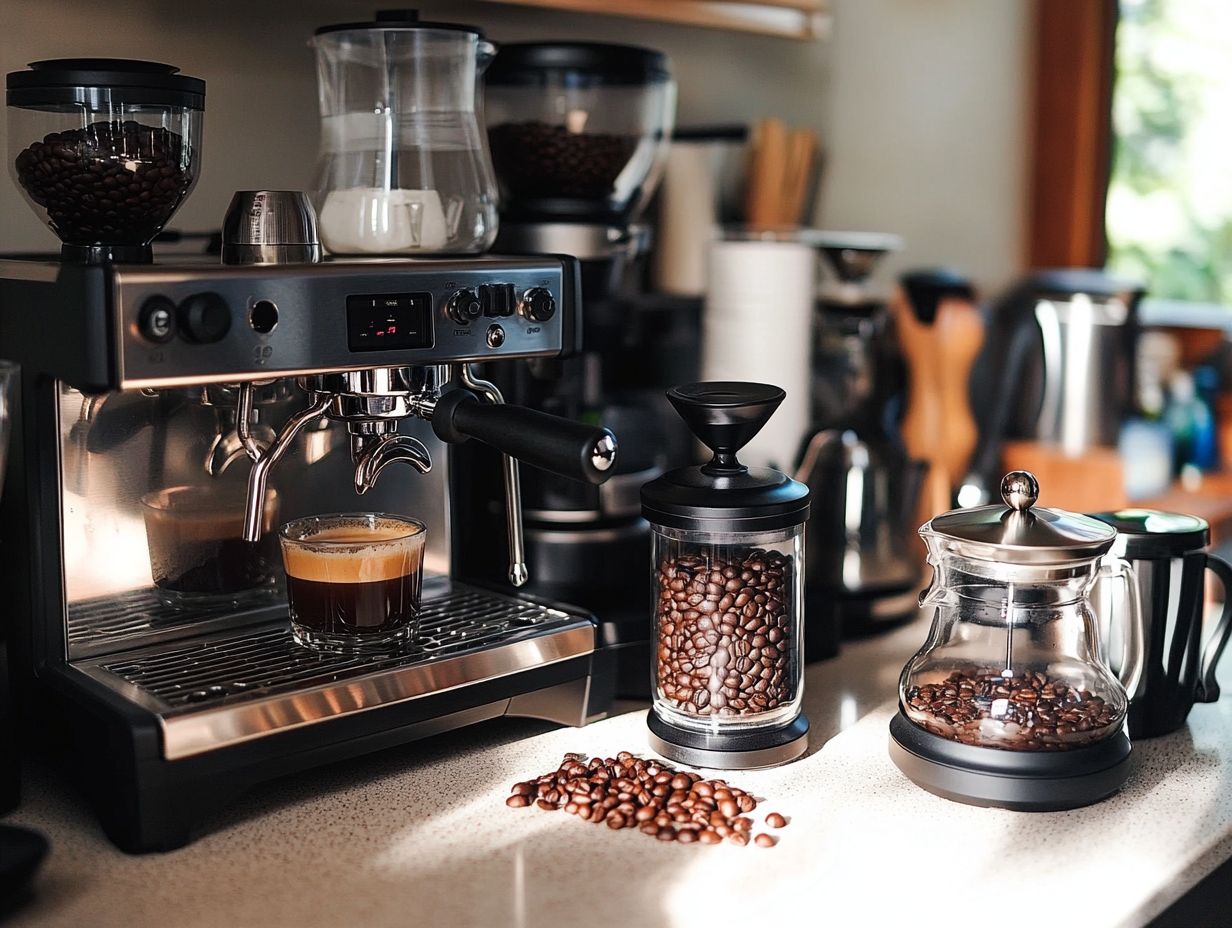
Dive into the thrilling world of coffee customization! As a home barista, you have the exciting opportunity to craft personalized beverages that reflect your unique tastes. Experiment with an array of flavor notes and ingredients to create delightful drinks.
This journey into coffee customization can be straightforward or elaborate. Incorporating flavored syrups like caramel, vanilla, or hazelnut can effortlessly transform a basic brew into a delightful treat. Experiment with syrups from brands like Verve and Onyx. Adjusting the type of milk whether you prefer almond, oat, or traditional dairy from Oatly can significantly enhance the texture and flavor profile of your drink. If you re a spice enthusiast, consider adding a sprinkle of cinnamon or a dash of nutmeg for that warm kick. Brands such as Verve and Onyx offer excellent spice options.
The real magic lies in exploring various combinations. Mixing chocolate with a hint of chili or pairing maple syrup with a dash of sea salt can elevate your regular cup of coffee into an extraordinary experience. Follow brewing guides from Clive or Greater Goods for additional inspiration.
Frequently Asked Questions
What are essential brewing techniques for home baristas?
The essential brewing techniques for home baristas include proper grind size, water temperature, brew time, and coffee-to-water ratio. Following these techniques ensures optimal coffee extraction and enhances the taste of your brew.
Why is grind size important in home brewing?
Grind size affects flavor extraction from the coffee beans. Different brewing methods require different grind sizes to achieve the best results.
What is the best water temperature for brewing coffee at home?
The best water temperature for brewing coffee at home is between 195-205 degrees Fahrenheit. This ensures proper extraction of flavor without burning the coffee, which is particularly important for specialty coffee.
How important is brew time in home brewing?
Brew time is crucial as it influences coffee strength and flavor. Too short a time results in weak coffee, while too long produces bitterness. Popular brewing methods like pour-over, French press, and espresso have different brew times, so adjust accordingly.
What is the recommended coffee-to-water ratio for home brewing and different brewing methods?
The recommended coffee-to-water ratio for home brewing is 1:16, which means 1 gram of coffee for every 16 grams of water. However, this can be adjusted based on personal preference and the type of brewing method used, such as AeroPress, auto-drip, or Chemex. Understanding brew ratios, which refer to the proportion of coffee to water, can significantly impact your coffee’s flavor notes.
How can I ensure consistency in my home brewing techniques as a home barista?
Measure your ingredients accurately to ensure consistency in home brewing. Use a timer and keep a record of your brewing techniques to make adjustments for future brews. As a home barista, consider using high-quality coffee beans and equipment like an espresso machine or a pour-over setup like a Hario V60. Cleaning cycles for machines and understanding coffee extraction will help maintain flavor integrity.

